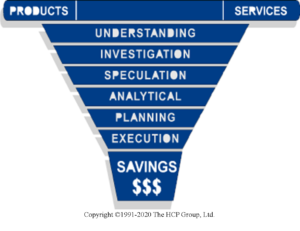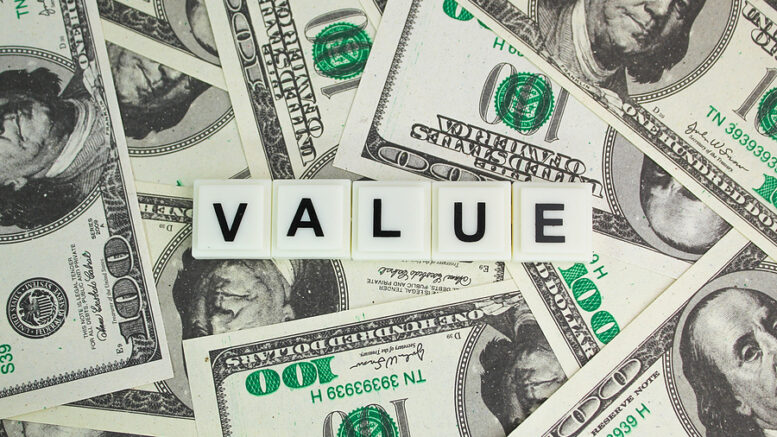I just read a healthcare magazine article that claimed that the definition of value analysis is Quality/Cost = Value Analysis. Nothing could be further from the truth. Larry Miles, the Father of Value Analysis, defined value analysis mathematically as Function/Cost = Best Value, since value analysis is defined classically as the study of function and the search for lower cost alternatives. In fact, value analysis practitioners didn’t even talk about quality until the 1980s when Edward Deming’s Total Quality Management theories started to take hold in Japan.
Value Analysis Can Fill Many Roles
Although VA can be extremely effective in the evaluation of new products, services, and technologies, discovering substitutions, and improving quality, it was designed to save money. For the best results, we recommend that you follow Miles’ six-step value analysis process as follows:
1. Understanding Phase: What is to be accomplished? What are our goals for this value analysis study? For example, studying the acceptability of a requested new surgeon’s glove could be a goal. Then, you would collect all information available about this surgeon’s glove (i.e., history, manufacturer data, third party data, user interviews, observations, etc.) to set the stage for your Investigative Phase.
2. Investigative Phase: In this VA phase, you define the primary (protect surgeons and patients), secondary (none), and aesthetic (size, color, tactile feel, strength and sensitivity, powdered, cuff, fit, comfort etc.) functions required (not desired) by your surgical staff to meet their requirements exactly.
3. Speculation Phase: In this step you would brainstorm to uncover a lower cost alternative (if any) for the surgeon’s gloves you have just specified. It could mean testing how sensitive the gloves need to be for the tactile feel or strength your staff prefers compared to different brands. This exercise could make a world of difference in your cost per pair and the quality of your gloves.
4. Analytical Phase: This is where you do the math, based on the alternatives you have chosen in your Speculation Phase, on what option is the best value (not best price) for your customers. In some cases, your best value product, service, or technology could be even higher priced than your comparables, but it meets your customers’ requirements exactly.
5. Planning Phase: In this phase you plan for the implementation of your newly chosen product, service, or technology. Do you need to have in-service education? Do you need to deplete your existing stock before ordering the new product? How are you going to communicate this change to the affected customers?
 6. Execution Phase: This last phase is where you incorporate your Planning Phase into a check list for action. Then, you need to decide who is going to be responsible for the execution plan (nursing, supply chain, operating room, etc.) to introduce this new product, service, or technology into your hospital, system, or IDN.
6. Execution Phase: This last phase is where you incorporate your Planning Phase into a check list for action. Then, you need to decide who is going to be responsible for the execution plan (nursing, supply chain, operating room, etc.) to introduce this new product, service, or technology into your hospital, system, or IDN.
It is easy to come up with your own version of value analysis, but much more cost effective if you employ the value analysis process (shown above) that has a 60-year history of reducing the lifecycle cost of a product, service, or technology without affecting its quality. Why reinvent the wheel when it has already been refined for you?
VA Teams Make a Difference
It was recently brought to my attention that every hospital doesn’t have a value analysis team or committee to manage and control their products, services, and technologies from conception to disposition. Since 96% of the life cycle cost of a product, service, or technology is incurred after the purchase, any hospital that doesn’t have a VA team to control these costs is losing hundreds of thousands of dollars annually in waste and inefficiencies in their supply streams.
That’s why value analysis teams make the difference at every size healthcare organization. In fact, we have uncovered over 1 million dollars in utilization misalignments in hospitals as small as 25 beds. So, if you don’t have a VA team in place at your healthcare organization, it is time to establish one just to fill the hole in your bucket that is losing thousands of dollars as you are reading this article.
| About Robert T. Yokl, Founder & Chief Value Strategist for SVAH Solutions |
|---|
| Robert T. Yokl is President and Chief Value Strategist at SVAH Solutions. He has four decades of experience as a healthcare supply chain manager and consultant, and also is the co-creator of the Clinitrack Value Analysis Software and Utilizer Clinical Utilization Management Dashboard that moves beyond price for even deeper and broader clinical supply utilization savings. Yokl is a member of Bellwether League’s Bellwether Class of 2018. https://www.SVAH-Solutions.com https://www.SavingsValidator.com |
Articles you may like:
Healthcare Value Analysis Leadership Interview: Vendor Value
Healthcare Supply Chain: What Happens If You Run Out Of Price Savings?





